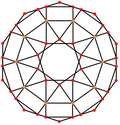Top Qs
Timeline
Chat
Perspective
Deltoidal hexecontahedron
Catalan solid with 60 faces From Wikipedia, the free encyclopedia
Remove ads
In geometry, a deltoidal hexecontahedron (also sometimes called a trapezoidal hexecontahedron, a strombic hexecontahedron, or a tetragonal hexacontahedron[1]) is a Catalan solid which is the dual polyhedron of the rhombicosidodecahedron, an Archimedean solid. It is one of six Catalan solids to not have a Hamiltonian path among its vertices.[2]

It is topologically identical to the nonconvex rhombic hexecontahedron.
Remove ads
Lengths and angles
The 60 faces are deltoids or kites. The short and long edges of each kite are in the ratio ≈ 1:1.539344663...
The angle between two short edges in a single face is ≈ 118.2686774705°. The opposite angle, between long edges, is ≈ 67.783011547435°. The other two angles of each face, between a short and a long edge each, are both equal to ≈ 86.97415549104°.
The dihedral angle between any pair of adjacent faces is ≈ 154.12136312578°.
Remove ads
Topology
Topologically, the deltoidal hexecontahedron is identical to the nonconvex rhombic hexecontahedron. The deltoidal hexecontahedron can be derived from a dodecahedron (or icosahedron) by pushing the face centers, edge centers and vertices out to different radii from the body center. The radii are chosen so that the resulting shape has planar kite faces each such that vertices go to degree-3 corners, faces to degree-five corners, and edge centers to degree-four points.
Remove ads
Cartesian coordinates
The 62 vertices of the deltoidal hexecontahedron fall in three sets centered on the origin:
- Twelve vertices are of the form of a unit circumradius regular icosahedron.
- Twenty vertices are of the form of a scaled regular dodecahedron.
- Thirty vertices are of the form of a scaled Icosidodecahedron.
These hulls are visualized in the figure below:
Orthogonal projections
The deltoidal hexecontahedron has 3 symmetry positions located on the 3 types of vertices:
Variations

The deltoidal hexecontahedron can be constructed from either the regular icosahedron or regular dodecahedron by adding vertices mid-edge, and mid-face, and creating new edges from each edge center to the face centers. Conway polyhedron notation would give these as oI, and oD, ortho-icosahedron, and ortho-dodecahedron. These geometric variations exist as a continuum along one degree of freedom.
Remove ads
Related polyhedra and tilings

When projected onto a sphere (see right), it can be seen that the edges make up the edges of an icosahedron and dodecahedron arranged in their dual positions.
This tiling is topologically related as a part of sequence of deltoidal polyhedra with face figure (V3.4.n.4), and continues as tilings of the hyperbolic plane. These face-transitive figures have (*n32) reflectional symmetry.
Remove ads
See also
References
External links
Wikiwand - on
Seamless Wikipedia browsing. On steroids.
Remove ads














































